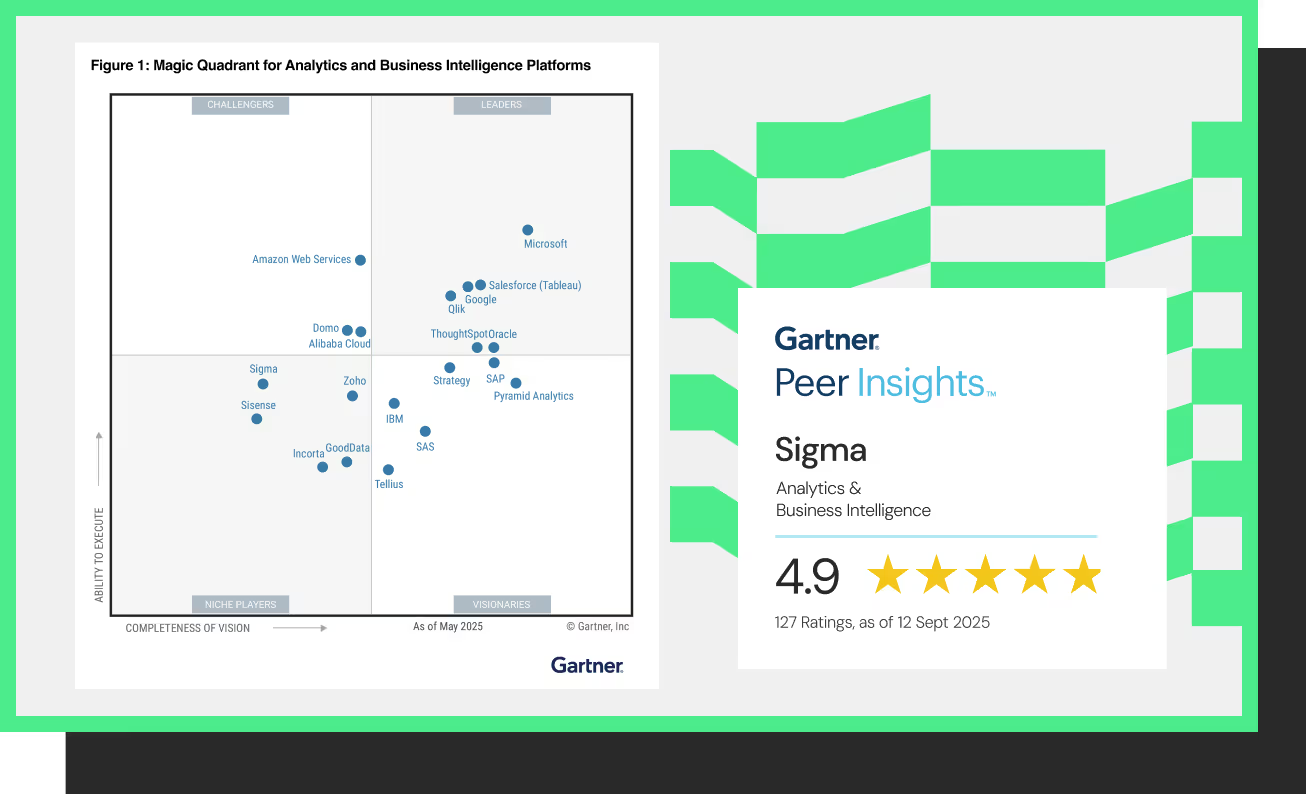Work with data in the spreadsheet format—and functions—you already know.
Don’t choose between speed-to-insight and scalability. Sigma dashboards get you both.
Know how to use a spreadsheet? Now you can build a data application.
Generate sustainable revenue by using Embedded Applications with Sigma to sell data as a product to your existing customers.
Top teams choose Sigma.
See for yourself. Sigma is a G2 crowd favorite, backed by countless reviews.
Verified User in Information Technology and Services

No row limits enables users to analyze massive datasets without restrictions

Ad-hoc calculations are limited by arbitrary results, starting as low as 500 rows; self-service calculations are based on limited data, leading to results that are inaccurate and misleading

Flexible paths allow users to drill into any data point using any field for further analysis without additional set-up

Drill paths in OmniML are rigid and predefined, limiting users’ ability to explore metrics on their own

Explore data freely using familiar spreadsheet syntax and a no-code GUI, without relying on data teams or predefined questions

Accurate answers require OmniML, limiting iterative exploration and self-service by forcing reliance on predefined questions or the data team

Multiple editors can collaborate in real-time with data securely written to the warehouse; version control and RLS/CLS ensures governance and prevents data loss from overwrites

Only supports CSV uploads, limiting collaboration and lacking governance; lacks robust front-end and writeback needed for line-of-business data applications

Build applications directly on your data warehouse; collect and writeback data to the cloud, automate workflows, and trigger actions

Does not support native data application development; CSV uploads have a fixed record limit and by default, do not write data back to the database

Flexible layout and design allow for granular control and easy to understand interfaces for end users

Rigid layouts force filters to the top of dashboards; customization limited to individual visualizations

Flexible data modeling with modular governance that can be leveraged across the entire organization—no proprietary languages required

Modeling layer enforces business logic and metric definitions in code (OmniML) making them inaccessible to non-technical users due to reliance on code and proprietary modeling languages

Utilizes warehouse caching mechanisms to securely enhance performance, reduce query times, and ensure data is never stored or exposed in external caches

Utilizes external caching mechanisms to improve performance but poses a security risk by storing proprietary and sensitive data outside the warehouse

Custom functions insure teams can leverage everything done in the warehouse; AI query, UDFs, ML models, and native functions like Cortex in Snowflake

Users must know SQL to both create and leverage with these functions limiting their reach and capabilities

Tracks changes to dashboards, enabling granular reversion and management of visual updates, enabling the entire organization to make their own changes with the safety of full rollbacks

Version control is managed externally in tools like GitHub, GitLab, or Azure DevOps, requiring third-party skillsets

Provides a robust SQL editor that can effectively handle mixed querying allowing for analysts to do ad-hoc analysis and share results

Supports custom SQL queries but does not allow formixed querying, limiting analysis

Offers assistance, resources, and robust documentation via live chat for all users within the platform

Offers documentation and community FAQs but no immediate in-product support
Top organizations choose Sigma. See for yourself.
































Read about Sigma's first-time recognition in this report.


WATCH THE VIDEO


LEARN ABOUT WRITE BACK


Read their STORY
